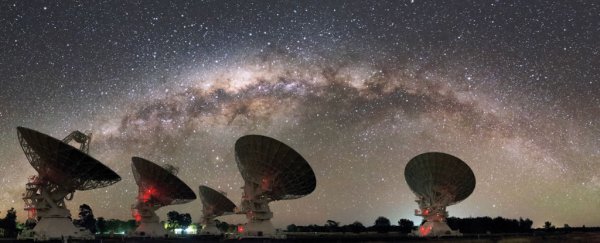Scientists have observed mysterious lumps of matter that lie in interstellar gas clouds, detecting their overall forms for the first time.
According to astronomers in Australia, these invisible structures could exist in a number of shapes, including noodles, lasagne sheets, or hazelnuts, and while they don't understand exactly what these formations do, the new findings help to clarify something that has puzzled scientists for decades.
"They could radically change ideas about this interstellar gas, which is the Galaxy's star recycling depot, housing material from old stars that will be refashioned into new ones," said Keith Bannister, a researcher with CSIRO.
The mysterious lumps were originally detected decades ago, when astronomers detected variations in radio waves from a distant galaxy. These events came to be understood as evidence of an invisible atmosphere that exists in between stars, consisting of a thin gas of electrically charged particles.
"Lumps in this gas work like lenses, focusing and defocusing the radio waves, making them appear to strengthen and weaken over a period of days, weeks or months," said Bannister.
These episodes, called extreme scattering events (ESE), have long been extremely difficult to detect, but by using CSIRO's Compact Array telescope in eastern Australia, Bannister and his team developed a new radio survey technique that allows ESEs to be identified in real time.
Directing the telescope at a quasar called PKS 1939–315 in the constellation of Sagittarius, the researchers were able to watch such a lensing event take place for a year.
According to Bannister, the formations are extremely large, approximately the size of the Earth's orbit around the Sun. The object that the researchers have observed is located approximately 3,000 light-years from Earth.
While the scientists have found out much more about the dimensions of the lumps than was ever previously known, the exact shape of the matter remains elusive.
"We could be looking at a flat sheet, edge on," said one of the researchers, Cormac Reynolds. "Or we might be looking down the barrel of a hollow cylinder like a noodle, or at a spherical shell like a hazelnut."
It's not yet clear what the lenses actually are, but the astronomers believe they could be cold clouds of gas that stay pulled together by the force of their own gravity. If true, this suggests the clouds would make up a substantial fraction of the mass of the Milky Way.
Further research will hopefully clear up the matter further, in no small part due to the new methods developed by CSIRO.
"Our technique will uncover many more ESEs," the authors write in Science, "addressing a long-standing mystery of the small-scale gas structure of our Galaxy."
